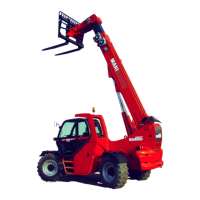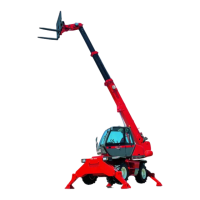1
11
MHT 10120 L M
SS
eries
C - Environment.
- Verify that the lighting in suitable
- Ensure that no person or objet is in the vicinity before raising the load.
Don’t make any incorrect manoeuvres.
- In the case of work near aerial lines, ensure that the safety distance is sufficient
between the working area of the lift truck and the aerial line.
You must consult your local electrical agency.
You could be electrocuted or seriously injured if you operate or park the lift truck too
close to power cables. You are strongly advised to ensure that the safety rules on the
site conform to the local regulations in force regarding all types of work carried out close
to power cables.
- Do not allow anybody to come near the working area of the lift truck or pass beneath
an elevated load.
- When using the lift truck on a slope, before raising the jib, ensure that the ground is
horizontal. However, fork lift trucks provided with level correctors and/or stabilizers can
operate on transverse slopes, provided this slope is corrected (See paragraph: G -
LIFT TRUCK HORIZONTALITY in the Chapter: HANDLING A LOAD).
- Travelling on a longitudinal slope :
• Drive and brake gently.
• Moving without load : Forks or attachment facing downhill
.
• Moving with load : Forks or attachment facing uphill
.
- Ensure that scaffolding, loading platform or pile are capable of bearing the weight.
- Ensure the stability and solidity of the ground before depositing a load.
D - Handling
- Always consider safety and only transport balanced and correctly secured loads to
avoid any risk of tipping.
- Fully engage forks under the load and move it in the transport position (The forks 300
mm from the ground, the jib retracted to the maximum and the carriage sloping back-
wards).
- For obvious reasons regarding the lift truck’s stability and clear visibility of the sur-
rounding environment, only move the lift truck when the jib is in the transport position.
- Do not manoeuvre the lift truck with the jib in the raised position unless under excep-
tional circumstances and then with extreme caution, at very low speed and using gen-
tle braking. Ensure that visibility is adequate and get another person to guide you
along if necessary.
- Never shift the position of the load while the lift truck is in motion.
- Never drive too fast or brake abruptly when carrying a load.
- During handling, drive at low speed.
- Check the load, particularly when turning corners and especially if it is very bulky.
- Secure unstable loads.
- Handle loads with caution, at slow speed, without sudden jerks when moving them at
significant heights and jib extention.
In the event of high winds or storms, do not carry out handling work that jeopardizes the
stability of the lift truck and its load,
- Do not change direction sharply and at high speed.

